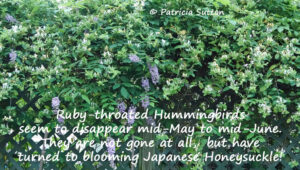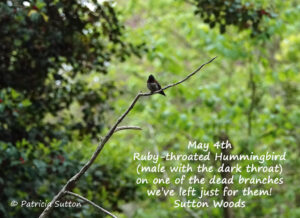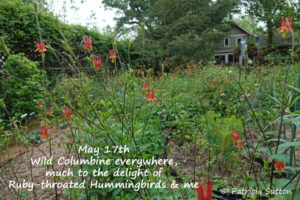Our Red Buckeye in deep shade in our woods was busy with hummingbird activity until it waned. I took this photo while counting the 80+ flower clusters on our 14-year-old tree on April 25th.
Through April and early May, they were drawn to all the spring-blooming goodies I’ve planted to attract them (Wild Columbine, Red Buckeye, Lyre-leaf Sage, Coral Honeysuckle, Coral Bells, blueberries, and Pinxterbloom Azalea). If you are new to native plant gardening, be sure to check out my post:
Some Sources of Native Plants, 2025
to learn where you can purchase them!
Since their diet is also made up of soft-bodied insects (the protein they need), they find those “a plenty” in our half-acre of native plants.
This year, by about May 16th Ruby-throated Hummingbird activity dropped off suddenly in our yard. Until then they were emptying five feeders (with four ounces each) every few days (last year we noticed their disappearance about May 18th). The average person would think that they were gone (or so it seemed), but we knew better from years and years and years of wildlife gardening experience!
Sure enough, their disappearance around this time of year each spring coincides with the blooming of Japanese Honeysuckle. Each mid-May through about the 8th or 9th or 10th of June, Ruby-throated Hummingbird sightings drop off abruptly. Many assume that their hummingbirds have left, but in fact they are very distracted by and feeding on blooming Japanese Honeysuckle instead.
 On a cool evening, the sweet scent of Japanese Honeysuckle drifts in my open window. Yes it is highly invasive, and we’ve removed it and are always on the lookout for seedlings in our woods and elsewhere on our property. But a mass of it covers the chain link fence that surrounds our backyard. Because it grows up and over the chain link fence from each of our neighbors’ yards (to either side), we let it be. It is too mighty a task to remove it.
On a cool evening, the sweet scent of Japanese Honeysuckle drifts in my open window. Yes it is highly invasive, and we’ve removed it and are always on the lookout for seedlings in our woods and elsewhere on our property. But a mass of it covers the chain link fence that surrounds our backyard. Because it grows up and over the chain link fence from each of our neighbors’ yards (to either side), we let it be. It is too mighty a task to remove it.
 So, wait patiently until about June 8th, or 9th, or 10th and your Ruby-throated Hummingbirds will be back in force. Do not let them return to icky, poorly maintained hummingbird feeders. Keep up your weekly feeder maintenance: cleaning and refilling with fresh solution.
So, wait patiently until about June 8th, or 9th, or 10th and your Ruby-throated Hummingbirds will be back in force. Do not let them return to icky, poorly maintained hummingbird feeders. Keep up your weekly feeder maintenance: cleaning and refilling with fresh solution.
As a long-time naturalist and wildlife gardener, I’ve shared this “quiet hummingbird period” in my Hummingbird Fact Sheet for over 40 years now (point 5 under “Feeder Maintainance,”) but still people are caught by surprise when activity drops way off.
 In addition to well-maintained feeders, be sure to provide native nectar plants Ruby-throated Hummingbirds are drawn to, like Foxglove Beardtongue, a great native perennial during the quiet bloom period from late May to mid-June.
In addition to well-maintained feeders, be sure to provide native nectar plants Ruby-throated Hummingbirds are drawn to, like Foxglove Beardtongue, a great native perennial during the quiet bloom period from late May to mid-June.
If any of your neighbors are swayed to hire one of the Mosquito and Tick Removal companies, speak to them about your hummingbirds and share that the sprays used by these companies impact hummingbirds, the insects they need to feed on, and many, many beneficial insects. Read my post, “Help! A Private Company is Spraying The Neighbor’s Yard for Mosquitoes.” It contains many more details on this topic. You might also want to read the excellent article on this topic (“What are Eco-Friendly Ways to Control Backyard Bugs“) that was in the New York Times climate desk on June 4, 2024.
Be sure to read my other Hummingbird POSTS:
Ruby-throated Hummingbird — Part One — SPRING ARRIVAL
Ruby-throated Hummingbirds: How to Attract Them
Happy Wildlife Gardening,
Pat



In what state are you in?
Perhaps states or areas have reduced numbers of Hummingbirds while other areas do not.
Good question, Karen. I speak from our experience in southern New Jersey, Cape May County. Others should weigh in. Pat
Hi Pat,
I too have a mass of Japaneses honeysuckle that I can’t be rid of.
Is there a particular time of day for hummer feedings?
Hi Randi, Ruby-throated Hummingbirds have a really high metabolism. To maintain that they need to feed frequently from the minute they get up to the minute they go to bed. I have seen them feeding during torrential rainstorms, hurricanes, and well after dusk on the eve of their southbound migration. They have to feed all day long. But their crop can only hold so much, so they need to sit frequently and process what they’ve drunk until their crop empties enough to head out for more. A really FUN read is The Birder’s Handbook, by Paul Ehrlich, David Dobkin, & Darryl Wheye. This book is packed with “pearls of wisdom” natural history facts about all of our birds, especially in the Essays. I used to know all sorts of facts, including the answer to your question when I led “Hummingbird Walks” with CMBO (Cape May Bird Observatory), but I had to refresh my memory & look up the answer to your question in that book. Here tis: “A hummingbird makes about 14-18 foraging bouts per hour, each taking less than a minute. For the remainder of the hour the bird quietly perches,” processes, and voids the liquid after it has gotten what it needs out of it. “What a hummingbird drinks in a day is the rough equivalent of a human voiding 20 gallons of water a day!” Imagine that!